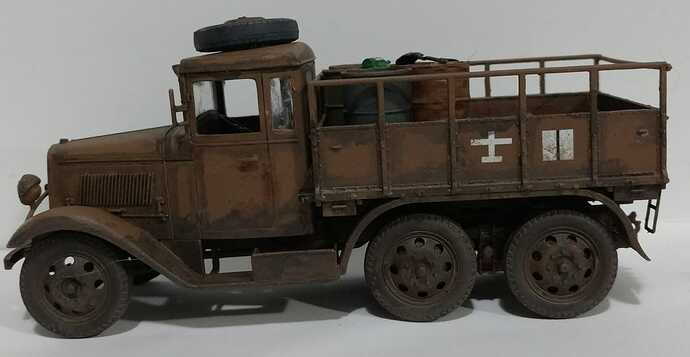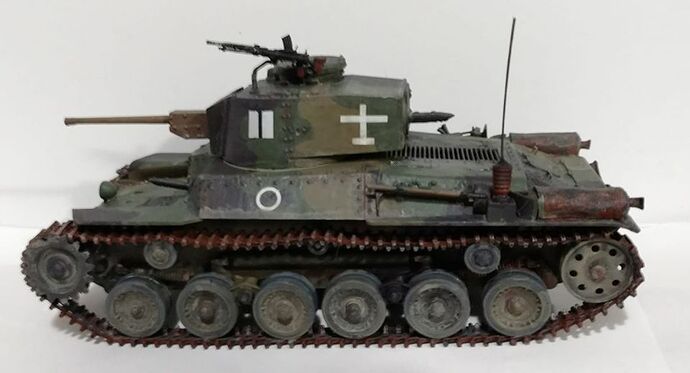IJA vehicle paint colors have the same name as the aircraft colors. Same colors or different? Also, Vallejo has 2 different IJA grey greens … 71326 IJA Grey Green and 71321 IJA Light Grey Green, implying there was a change in the color. They show the light one for the Ki-27 (Sino-Japanese War) and the other for undersides later. (AK has just 1, AK11899 IJA #1 Hairyokushoku (Grey-Green), for all applications. Planning on a Ki-27 (1937-39) and a China based Ki-46II (1943-ish) Any thoughts?
I can answer your first question. IJA vehicle and aircraft colors are the same. AK Real Colors makes all of them. Highly recommended.
Have the Hataka IJA set. Been real happy with the results. ( FineMolds Isuzu Type 94 with Hataka IJN Khaki)
With the colors being the same , will save me some money working on a few aircraft. (FineMolds Type 97 Chi Ha Shinhoto in Hataka colors)
Now to figure out the grey question.
Lots of reading here but very well researched and thought out:
Ki-27 cockpit should be a blue-grey:
About the two Japanese Army gray green as mentioned. The first one the light green was the standard overall color that some people refer to as “pistachio,” Army Hairyokushoku. The other gray green is a later War mixture that was similar, but warmer. It was a lightened color of an IJA top camo color. That color is discussed in these two links:
As for what overall gray green a china-based Dinah would be, I’m still looking for definitive information, although I believe with high probability that it would be the light gray green color.
I love a simple answer. I’ve checked out the aviation of Japan site. Gotten a few gems from there, but it’s like strip mining … sift through a couple hundred tons of dirt to get an ounce… All that Munsel scale and Thorpe scale stuff is way beyond my needs or comprehension. As for the greys, what are we talking, “late war” … 44-45? The Ki-46 I’m planning is allegedly in service in 1943. I’d think the early grey would get the nod. (unless the “late” one came in in 43 (didn’t IJN change their scheme in mid 43?) then we are back to a coin toss. Another question popped up. Mitsubishi used a “brown” on late production Ki-46 . Yes? No? Maybe? (I know the Brits went to SCC-2 brown for vehicles when one of the elements to make greens became scarce. Same scenario?) Sooo … off to digest all the stuff you sent. ![]() Thanks.
Thanks.
I tend to get carried away with details, now try to make my answers or observations concise. Nick’s research can be quite technical. Apparently he has the favor of several Japanese sources, judging by the people he acknowledges in his articles. That is why his site are my “go to” sources.
By the way, Nick also publishes a primer on Japanese armor and vehicle colors. Like all of his work, it’s very technical in terms of his spectral analysis of colors.
About brown colored Dinahs. The answer is yes, apparently there were some painted brown at the factory. Here are excerpts from some of his articles, with the link to this specific article.
“Allowing for scale the khaki brown finish is uncannily close to the colour cited by Noburo Shimoune as being factory applied to both the late production Ki-46-III and Ki-67.” - Aviation of Japan 日本の航空史: Dinah and Jay Part Two - Building a Classic
“JAAF # 7 paint colour Ohryoku Nana Go Shoku (Yellow Green No.7 Colour), an olive brown shade like British khaki drab…” - Aviation of Japan 日本の航空史: "Dinah with the Finah Linah"
From J-aircraft, numerous posts about the Dinah (. Ki-46 Threads. ); about three paragraphs down James Lansdale posted of a friend who explored a Dinah it New Guinea. It was painted, “…of camouflage had been field-applied over all upper surfaces. The gray-green finish had oxidized to a blue-gray powder in many places. He removed the all-metal rudder trim tab and submitted it for analysis by this author and James I. LONG.”
That gray - green is described in another post, "It is somewhat glossy hairyokushoku (gray-green) which is a close match to FS-16350. "
This is a PDF from 2015 from the Royal Air Force Museum, recounting the history of their brown Dinah:
I hope this helps.
Fred
1943, the Dinah would have worn the “pistachio” grey-green. I still call it pistachio because I read that once and it’s the way I remember it, although using that term makes a lot of Japanese color researchers cringe. It makes me cringe too but I just can’t think of the correct word off the top of my head.
That late war gray was found on factory painted Franks. Probably other Army aircraft but I can’t think of any right off hand. Yes, 44-45. If I recall correctly, and it’s in that one link I sent you to Aviation of Japan, Franks were delivered from the factory in bare metal, and camouflaged in the field. The grains probably very depending on what was on stock but some of them were painted in that green with a slight bluish tint to it. Later they were painted at the factory in the aforementioned Olive and the late war gray. I don’t recall encountering any discussion of that late War color being applied as an overall color for an aircraft.
IJN did change their scheme mid-war. I’ll try to find my notes and tell you the date of the order that was mid to late 43. The Zeke 52s that arrived at Rabaul for painted in the blackish green top color with gray underside.
Sometime in 1944 Japanese high command ordered the Army and Navy to revise their colors again, and even combine/share some of the colors. I’ll try to dig up that order, too.
If I read the article right, what I discovered from the article linked to below is that the Japanese Army put out a paint regulation in 1935, and the Japanese Navy put out a new one in April 1942, “Kari- kikaku 117 Shiki-betsu Hyojun” (Provisional Standard 117 Color Norms).
Between the Army and Navy are probably 70 to 80 colors, and in late 1944 the Japanese decided to streamline the number of paints and combine them. That order was
8609 colour standard of Feb 1945.
The article on referencing explains it in far more detail in the link below. It also talks about inconsistent descriptions of some colors and making the Army and Navy play nicer together.

